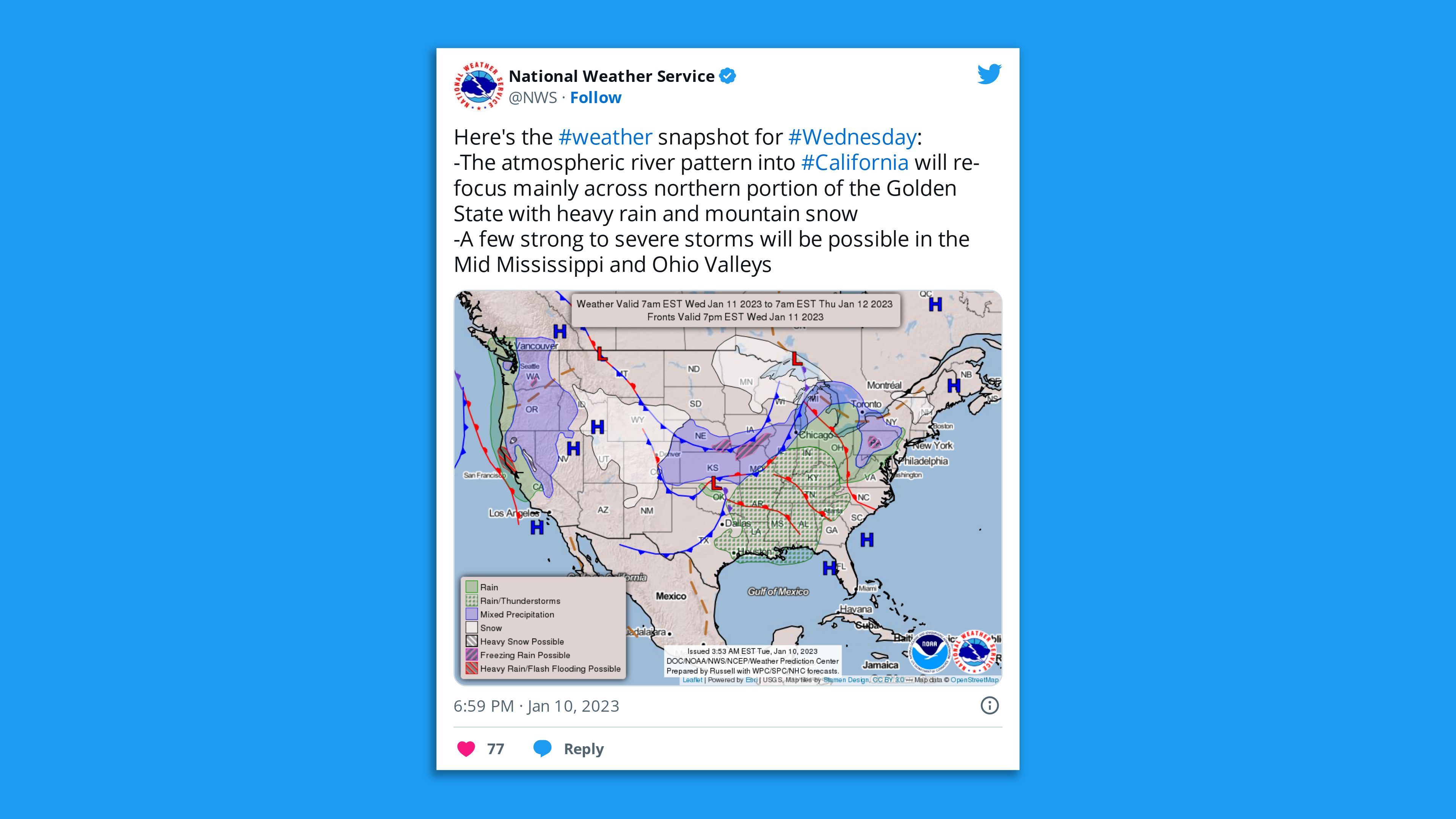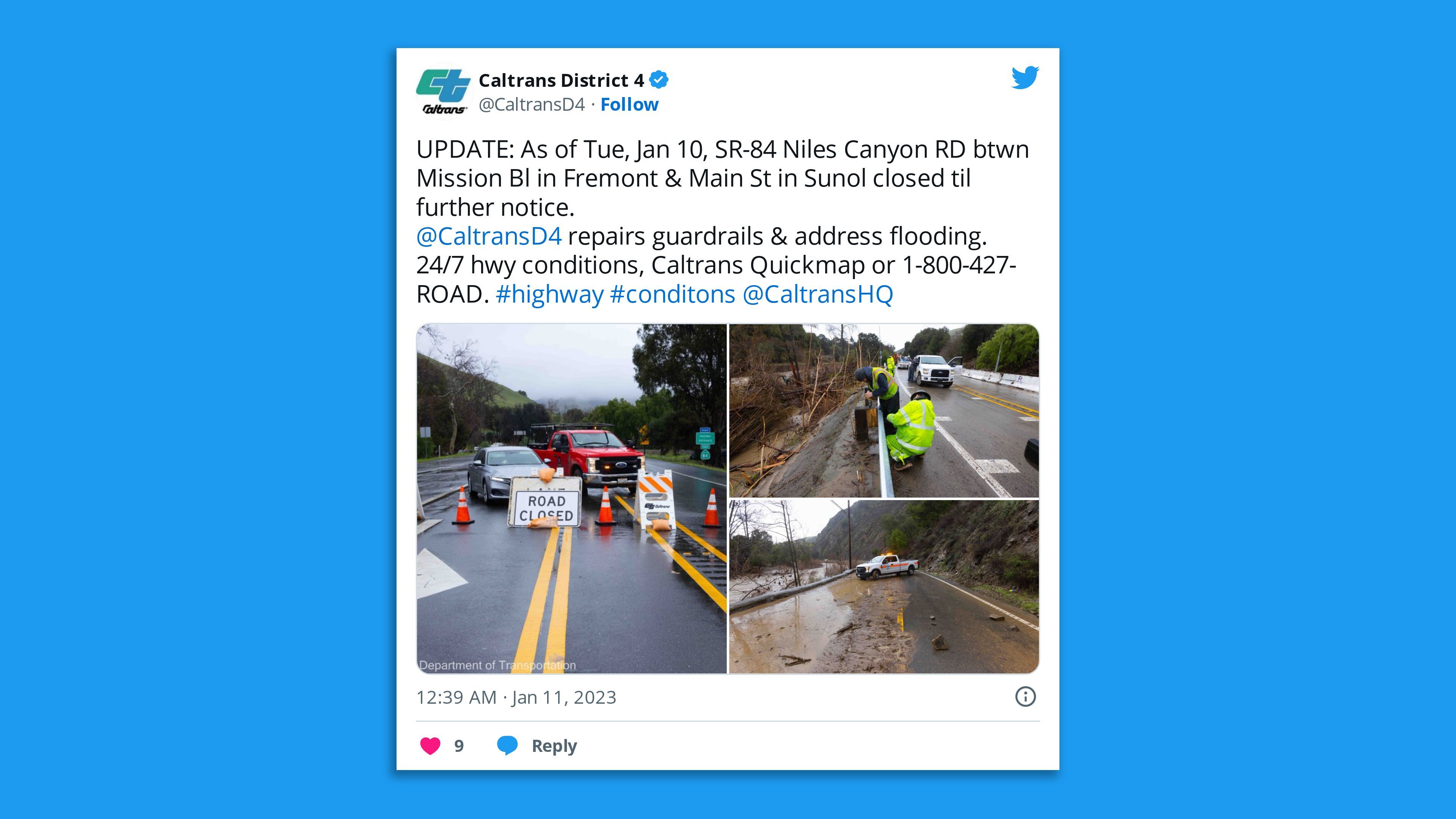The "endless stream"of atmospheric river events is set to refocus across northern California Wednesday, as "high impact" heavy precipitation continues across much of the state, according to the National Weather Service.
The big picture: The latest deadly storm triggered evacuations and the closure of schools and major roads across California this week due to the threat of "torrential rain, widespread flooding, rapid water rises, mudslides and landslides with possible debris flows, heavy mountain snow and gusty high winds," per the NWS.

- California Gov. Gavin Newsom said the death toll from the barrage of severe storm systems increased to 17 on Tuesday, as authorities resumed the search for a 5-year-old boy swept away in floodwaters near Paso Robles in central coastal California on Monday.
- Severe thunderstorms have been sweeping across the state, from north-central California to the Los Angeles Basin. These storms are bringing strong winds and hail, and have knocked out power to tens of thousands while also prompting rare tornado warnings.
By the numbers: Nearly all of California has received rainfall totals 400% to 600% above average in the past several weeks, the National Weather Service noted in a forecast discussion Monday.
- More than 18 inches of rain have fallen in the mountains of Santa Barbara and Ventura counties, and as much as 11 inches in Los Angeles County, per the NWS.
- An additional 1 to 3 inches of rain predicted in the Bay Area for Wednesday will only worsen the flooding and mudslides that have forced thousands to evacuate.
Meanwhile, Santa Barbara County's Cachuma Reservoir rose almost 5 feet in 24 hours, NWS warning coordination meteorologist Eric Boldt said at a briefing Monday.
- Rainfall amounts in Southern California have been "incredible," the NWS stated.
Of note: An estimated 65,800 customers were without power early Wednesday.

State of play: Among the evacuation orders issued in response to the storm was one Monday for the entire town of Montecito in Santa Barbara County, on the fifth anniversary of a mudslide that killed 23 people, per AP.
Threat level: These storms have caused debris flows and flash flooding in areas where the ground has been weakened by recent wildfires, with multiple flood warnings associated with burn scars issued across Central California.
- They're also priming the slopes of the Sierra Nevada Mountains for avalanches.
- Total snowfall through Tuesday is predicted to be upwards of 6 feet for elevations above 7,000 feet, per the NWS. Statewide snowpack hit 215% of the average for the date on Tuesday, according to the state Department of Water Resources.
For the record: President Biden approved late Sunday California's emergency declaration request due to the storms, allowing federal aid to flow to the state.
What they're saying: "While each individual storm may not be unusually large, the impacts will be larger due to the number of storms and how quickly they arrive," Michael Anderson, California state climatologist with the California Department of Water Resources, told Axios via email.
- Anderson said there is enough reservoir capacity in the swelling Sacramento River system to absorb the precipitation.
Zoom in: The shift from bone-dry to extremely wet conditions is in line with what studies have been warning about for years — human-caused climate change is amplifying the effects of these extremes, making the dry years drier, and the wet periods wetter.
- While flooding, power outages and landslides threaten Californians in the near-term, these storms are boosting reservoir levels, severely depleted by the Southwest's megadrought.
- At the same time, the portion of California's annual precipitation that comes from atmospheric rivers is expected to increase as the climate warms, per Julie Kalansky of Scripps' Center for Western Weather and Water Extremes.
What's next: There's no end in sight to these storms through the end of the month.
Editor's note: This story has been updated with additional developments.
Rebecca Falconer contributed reporting.







